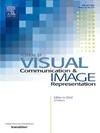QLight-Net:基于四元数的弱光图像增强网络
IF 3.1
4区 计算机科学
Q2 COMPUTER SCIENCE, INFORMATION SYSTEMS
Journal of Visual Communication and Image Representation
Pub Date : 2025-05-22
DOI:10.1016/j.jvcir.2025.104478
引用次数: 0
摘要
夜间拍摄的图像会受到各种各样的影响,如色彩失真、对比度低和噪声。许多现有的改进弱光图像的方法有时会放大噪声,导致颜色失真,并且缺乏更精细的细节。现有的方法需要大量的参数,这限制了这些方法在基于视觉的应用中的采用。在本文中,我们提出了一种QLight-Net方法,以相对较少的参数数量实现更好的增强。提出了深度四元数卷积和四元数交叉关注,发展了低光图像增强的双分支架构。该模型利用梯度分支提取颜色感知梯度特征。进一步,利用颜色分支提取渐变感知的颜色特征。该方法的LPIPS得分为0.047,超过了以往参数较少的最佳结果,SSIM和PSNR得分分别为0.88和29.05。我们的方法在计算效率和更好的增强之间取得了平衡。本文章由计算机程序翻译,如有差异,请以英文原文为准。
QLight-Net: Quaternion based low light image enhancement network
Images captured at night suffer from various degradations such as color distortion, low contrast, and noise. Many existing methods improve low-light images may sometimes amplify noise, cause color distortion, and lack finer details. The existing methods require larger number of parameters, which limits the adoption of these methods in vision-based applications. In this paper, we proposed a QLight-Net method to achieve a better enhancement with a comparably lower number of parameters. We proposed depth-wise quaternion convolution, and quaternion cross attention to develop the two-branch architecture for low-light image enhancement. The proposed model leverages gradient branch to extract color-aware gradient features. Further, It uses color branch to extract gradient-aware color features. The proposed method achieves an LPIPS score of 0.047, which surpasses the previous best results with lesser parameters, and achieves 0.88 and 29.05 scores of SSIM and PSNR, respectively. Our approach achieves a balance between computational efficiency and better enhancement.
求助全文
通过发布文献求助,成功后即可免费获取论文全文。
去求助
来源期刊

Journal of Visual Communication and Image Representation
工程技术-计算机:软件工程
CiteScore
5.40
自引率
11.50%
发文量
188
审稿时长
9.9 months
期刊介绍:
The Journal of Visual Communication and Image Representation publishes papers on state-of-the-art visual communication and image representation, with emphasis on novel technologies and theoretical work in this multidisciplinary area of pure and applied research. The field of visual communication and image representation is considered in its broadest sense and covers both digital and analog aspects as well as processing and communication in biological visual systems.
 求助内容:
求助内容: 应助结果提醒方式:
应助结果提醒方式:


